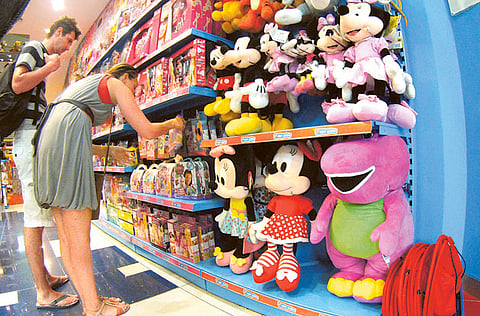Retail giants urged to let toys be toys
Parent-led campaign against segregation of toys says retailers are only reinforcing sexism

Dubai: Pink is for girls and blue is for boys — or is it?
Debate is growing as to whether toy stores should arrange their displays based on gender or theme.
A campaign launched by a UK-based lobbying group, ‘Let toys be toys’, is petitioning retail giants to stop separating their toys and labelling them according to gender.
The campaign group has negotiated with retailers to stop marketing their toys as exclusively for girls or boys and some retailers have said they will, in the future, keep the gender and theme issues in mind for future advertising campaigns to make them more neutral.
Dr Carey Kirk, a counselling psychologist at The LightHouse Arabia in Dubai, said that marketing children’s toys in a certain way can discourage children when choosing their future career paths.
“Regarding children’s toys, a lot of them are gender segregated. This is something that does contribute to prescribed gender roles in both women and men. For example, ‘Barbie’ focuses a lot on make-up and dressing up, which spreads a message on how girls should ideally look and dress,” said Dr Kirk.
According to the ‘Let toys be toys’ campaign, boys and girls are growing up being told that certain toys are for them, while others are not. Campaign supporters say this is not only confusing but extremely limiting as it strongly shapes children’s ideas about who they are and what they should be in the future — rather than what they want to be.
‘Let toys be toys’ is a parent-led campaign that believes that toys are for fun and learning — children should feel free to play with the toys that are most interesting to them. The campaign has received more than 7,500 signatures from supporters signing their petition, asking retailers in the UK to remove gender labels.
“We market our toys based on both gender and theme,” said Zakhia Addelsater, marketing associate at Hamleys in Dubai. “Usually some girls’ toys have separate sections in the store for big brands such as Barbie. However, we don’t separate our toys based on just gender,” he said.
Other well-known stores have also been influenced by this movement. The British store Harrods launched its new toy collection last summer, based on theme rather than gender.
A lot of parents living in the UAE have similar feelings towards this issue and have noticed a change in toy design and marketing over the years.
“When my kids were younger, I used to buy one toy for both of them to play with,” said Lebanese mother-of-three Farah Mansour, 56, a dentist living in Dubai.
“Back in the day, toys used to be suitable for both girls and boys, which saved me a lot of money. Nowadays, when watching friends of mine buy toys for their kids, they have to purchase separate toys — a toy specifically for the daughter and another for the son,” she said.
“I remember once my niece started screaming when her mother bought her a toy that was not pink. Gender stereotypes are present in today’s society unfortunately,” said Farah.
A book written by American author Carrie Goldman, Bullied: What every parent, teacher and kid needs to know about ending the cycle of fear, includes one entire chapter dedicated to gender specific marketing.
She explains that companies make twice as much money when segregating their toys, because a pink toy will sell best for girls and a blue one for boys. She continues to evaluate the problems that arise from this issue; such as children lose opportunities to develop and share skills, and they become marginalised if they choose to play with a toy that’s been assigned to the opposite gender.
“Boys’ toys tend to be more construction based and this unconsciously gives the image that these toys are not meant for girls, resulting in gender stereotypes. Toys aimed at boys such as construction sets are advertised and marketed in a certain way, discouraging girls to play with them. A lot of young girls may aspire to be architects and engineers but feel that they can’t because this is seen as a man’s job,” said Dr Kirk.
Sign up for the Daily Briefing
Get the latest news and updates straight to your inbox


